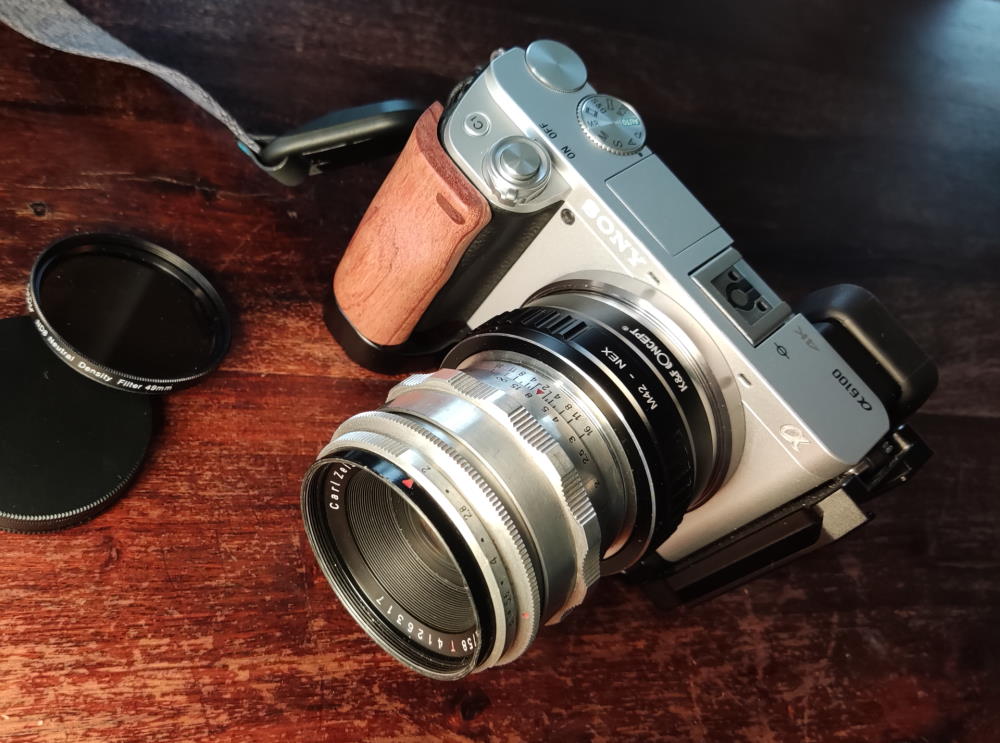
In my opinion, the following photos quite nicely answer the following question: How good performs the legendary classic Carl Zeiss Jena Biotar 58mm f2 full-frame lens made in 1953 adapted to the modern Sony a6100 digital camera with smaller APS-C sensor?
When the Carl Zeiss Jena Biotar type 58mm f2 lens is adapted to a Sony a6100 camera with an APS-C sensor, a crop-factor of 1.5 applies. That makes the field of view almost the same as a 85mm portrait lens used on a 35mm equivalent full-frame camera like the Sony a7ii.
On the one hand, the smaller APS-C sensor of the Sony a6100 camera compared to a full-frame sensor, means that only the middle part of the full-frame Biotar lens is used without the optically inferior corners of the lens. On the other hand, the optical resolution of 24 megapixel is demanded in the middle area of the lens without utilizing the complete lens.
When you click on an image in the galleries, following buttons will allow you to select some features, including a slideshow (which is auto-started for some galleries, you have to press the pause button to stop a slideshow):

Slideshow | Fullscreen | Image-Info | Original-size
Photos shot on a golf course with the classic Carl Zeiss Biotar 58mm f2 lens on a digital Sony a6100 APS-C camera
For the following photographs shot at a scenic golf course south of Munich, a Carl Zeiss Biotar 58mm f2 lens made in 1953 was used on a modern Sony a6100 camera with a small APS-C sensor. Expect the EUR 60 Russian copy Helios 44M-4 to deliver quite similar results. Thanks to talented golfer Rohan and Matthias for posing as models.
Beyond the swirly bokeh, what makes the Carl Zeiss Biotar 58mm f2 lens so special?
Answer: the wet-on-wet bokeh.
The term “bokeh” has been defined as the way the lens renders out-of-focus points of light. See more information about bokeh here: https://wikipedia.org/Bokeh
Although bokeh quality is a matter of individual taste, Rick Denney gives some good examples of which kind of bokehs are distracting, neutral or pleasing: http://www.rickdenney.com
Despite the swirly bokeh of the tested Carl Zeiss Jena Biotar lens, which show only under certain conditions (the swirly bokeh shows best at open aperture f2 when the distance to the object in focus is approx. 2m and when there are approx. 7m distance to a background which is out of focus), the way the Carl Zeiss Jena Biotar 58mm f2 lens made in 1953 render objects out of focus corresponds to the wet-on-wet technique for watercolor paintings, i.e. adding wet paint onto wet paper, allowing the added pigment to spread out unhindered.
Take a look at some crops of the photos shown in above galleries. In my opinion, the “characterful” wet-on-wet bokeh is the real star, not the object in focus:
Read more about the origin and history of the Carl Zeiss Biotar and Helios 44M-44 58mm f2 classic lenses here
Swirly Bokeh? The legendary Zeiss Biotar 58mm f2 vs. the Russian copy Helios 44M-4 58mm f2 lens
Rundown
The Carl Zeiss Jena Biotar 58mm f2 lens made in 1953 type proved able to deliver good images, with a beautiful image rendering character and bokeh when adapted to the digital Sony a6100 APS-C camera made in 2021.
Not all M42-to-Sony-e-mount adapters are compatible with the Carl Zeiss Biotar 58mm f2 lens, as with some adapters the lens cannot be completely turned inside due its large bulge into the adapter. With those incompatible adapters, focus on infinity is lost. If you want to adapt the Carl Zeiss Biotar lens, you are invited to ask for a compatible adapter in the comment section below.
Learnings:
- The classic Carl Zeiss Jena Biotar 58mm f2 lens adapted to a Sony a6100 APS-C camera is a perfect combo for shooting beautiful images with a characterful wet-on-wet bokeh.
- The main reasons for a good photo are – as always – motive, lighting and composition. An experienced photographer with an iPhone will take better photos than an amateur with EUR 5,000 worth of camera equipment.
- Never go out shooting in sunlight with the 58mm f2 Biotar lens without both an ND8 neutral density filter to avoid over exposure and a lens hood to avoid lens flares at open aperture.
- Playing with bokeh, creating it, or capturing it can be fun. Find a very informative article about bokeh from B&H here: https://www.bhphotovideo.com
- The Manual Focus Assist and Focus Peaking features of the Sony a6100 camera helped to easily accomplish the manual focus with the Carl Zeiss Biotar 58mm f2 lens made in 1953: